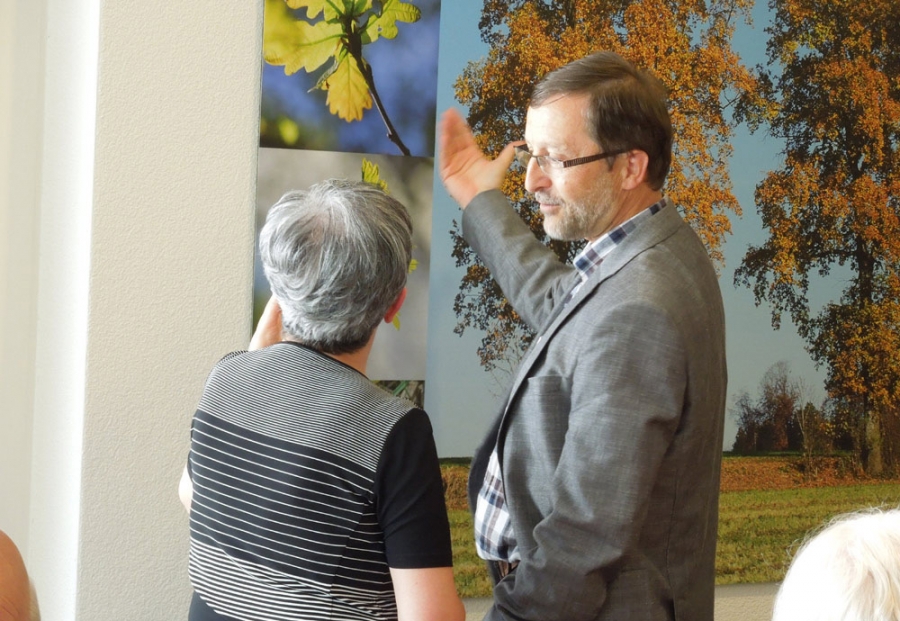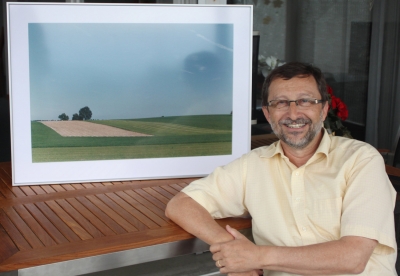Dear guests, dear Ueli, I am incredibly happy that the opening of Ueli‘s first show is taking place today. I have often wished that his artistic photographs should not just be in the photo negative archive nor in a folder in the PC and in the albums.
Some of you know his photographs from the Christmas / New Year cards, which have become a tradition, and maybe occasionally from his calendars.
What makes his photography special?
The way (the art) of seeing - looking - noticing - contemplating …… and then taking pictures.
But what is so special about it?
For this, let me go back a bit in time. Photography has meant a lot to Ueli, even long before I got to know him. I remember the photographs from our first days together very well: It was still the time of analog photography. Back then he often took black and white photographs. I also still very clearly remember his first Minolta cameras and the special lenses such as the telephoto lenses. The macro lens was one of his favorite lenses early on, and he avoided the wide-angle lens whenever possible.
When digital photography became possible for everyone approximately ten years ago, he initially ignored it. He knew that this technique would change photography a lot: In analogue photography, Ueli literally experimented, and almost every photo was actually a unique, carefully considered piece of art. Digital photography opened up new possibilities, and experimentation was given a lot more leeway.
But what now makes Ueli's photographs special?
It cannot be just about seeing, looking, noticing and contemplating. As a schoolboy he already enjoyed designing and dealing with details. This can be seen very well in his secondary school yearbooks, where we find titles designed in very clear, print-like letters. He was also happy to make hand-drawn geographical representations. In the drawing folder from his years at the teachers’ seminar in Hitzkirch there are small works of art, not necessarily aquarels, but rather technical studies and constructions - in other words, works shaped and influenced by his teachers, such as the biology teacher who invited them to look at plants under the binoculars and depicting them in pictures or in drawing lessons.
Concrete art for example by Richard Paul Lohse, Max Bill or Gottfried Honegger, fascinate Ueli: the lines, diagonales, areas appeal to him. These influences clearly show in his art: We find surfaces, lines, diagonals in his photography, as this is the way he looks at his surroundings: He immediately perceives lines and shapes in nature and cities, whereas I would just see a landscape, without recognizing these structures. He sees the spaces and forms unconsciously designed by farmers, for instance. This is what makes up his works from “far”.
What about the works from “near”? The field is fascinating as a surface and can be seen from different perspectives. While I typically look at a field from where I stand on a path, Ueli would crouch or climb on a wall or over a fence to look at it. He plays with the horizon, with which as a frame we look into and over the field. The field consists of many stalks which, if contemplated individually, show a lot of wonderful details. I see a plant with a stem, leaves, flower and fruit. Ueli sees the square stem, the leaf veins, the light in the flower, the shading of the fruit. And that's when he loves his macro lens.
Far and near -> The photographs on the invitation card are typical of his photography. We first see them from far and near, we discover new things, e.g. the bird in the green field. Lines and surfaces, light and shadow, calm and clarity - essential elements of Ueli’s photography.
Are these the elements through which Ueli's photographs reach us emotionally, touch us, so that we can't just simply go on, but have to see, look, notice, contemplate.
I wish you all open senses and pleasant moments when looking at the pictures. Great to have you here.
Trudi Fischer


